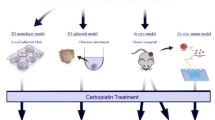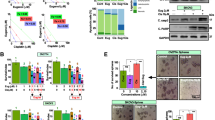Abstract
Purpose
In order to establish a more faithful model of clinically recurrent ovarian cancer after paclitaxel-based chemotherapy, a paclitaxel-resistant human ovarian cancer cell line was established in vivo, and its biological profiles were compared with the conventional in vitro established drug-resistant cell line.
Methods
An in vivo paclitaxel-resistant subline (OM1/Tvivo) was established from the parental human ovarian cancer cell line (OVMG1) by repeated paclitaxel administration into tumor-bearing mice. As a control, the in vivo drug-sensitive subline (OM1/Cvivo) was made in the same manner, without paclitaxel. An in vitro paclitaxel-resistant subline (OM1/Tvitro) was established by exposure to stepwise increased concentrations of the drug in a cell culture medium. Chromosomal analysis, evaluation of growth, invasiveness and metastasis, in vivo and in vitro drug sensitivity, and a pharmacokinetic study were performed.
Results
Both in vivo sublines confirmed their human origin by G-band chromosomal analysis and showed a similar cell growth rate in cell culture. As for in vivo tumor growth, OM1/Tvivo showed enhanced tumor growth property compared with OM1/Cvivo, while OM1/Tvitro lost tumorigenicity. Both OM1/Tvivo and OM1/Cvivo sublines as well as their parental OVMG1 could not form either invasive or metastatic lesions. Compared with the OM1/Cvivo subline, the OM1/Tvivo tumor showed stable drug-resistance and lower drug distribution after paclitaxel administration into mice, whereas cultured OM1/Tvivo cells lost both completely. On the other hand, an unreasonably higher level of drug-resistance and lower drug concentration was detected in vitro only in OM1/Tvitro cells after exposure to the drug in a culture medium.
Conclusions
These results suggest that the in vivo established paclitaxel-resistant cell line, rather than the conventional in vitro established cell line, is a suitable and faithful model for clinically recurrent tumors showing transformed aggressiveness. The in vivo specific drug-resistant mechanism should involve an interaction between the tumor and host stromal tissue rather than only changes in cellular drug sensitivity. The present study is probably the first report of an in vivo established paclitaxel-resistant human ovarian cancer cell line, and the elucidation of such an in vivo drug-resistance mechanism may be clinically important in preventing or overcoming acquired drug-resistant ovarian cancers recurring after paclitaxel-based chemotherapy.




Similar content being viewed by others
References
Abe Y, Ohnishi Y, Yoshimura M, Ota E, Ozeki Y, Oshika Y, Tokunaga T, Yamazaki H, Ueyema Y, Ogata T, Tamaoki N, Nakamura M (1996a) P-glycoprotein-mediated acquired multidrug-resistance of human lung cancer cells in vivo. Br J Cancer 74:1929–1934
Abe Y, Yamazaki H, Oshika Y, Suto R, Tsugu A, Ota E, Satoh H, Ohnishi Y, Yanagawa T, Ueyama Y, Tamaoki N, Nakamura M (1996b) Advantage of in vivo chemosensitivity assay to detect vincristine-resistance in a human epidermoid carcinoma xenograft. Anticancer Res 16:729–734
Antoine E, Pauwels C, Verrelle P, Lascaux V, Poupon MF (1988) In vivo emergence of a highly metastatic tumour cell line from a rat rhabdomyosarcoma after treatment with an alkylating agent. Br J Cancer 57:469–474
Bashir I, Sikora K, Abel P, Foster CS (1994) Establishment and in vivo characterization of multidrug-resistant dunning R3327 rat prostate-carcinoma cell-lines. Int J Cancer 57: 719–726
Biedler JL, Spengler BA (1994) Reverse transformation of multidrug-resistant cells. Cancer Metast Rev 13: 191–207
Coldman AJ, Goldie JH (1985) Role of mathematical modeling in protocol formulation in cancer chemotherapy. Cancer Treat Rep 69:1041–1048
Einzig AI, Wiervik PH, Sasloff J, Runowicz CD, Goldberg GL (1992) Phase II study and long-term follow-up of patients treated with paclitaxel for advanced ovarian adenocarcinoma. J Clin Oncol 10:1748–1753
Frankel A, Buckman R, Kerbel RS (1997) Abrogation of taxol-induced G2-M arrest and apoptosis in human ovarian cancer cells grown as multicellular tumor spheroids. Cancer Res 57:2388–2393
Fridman R, Giaccone G, Kanemoto T, Martin GR, Gazdar AF, Mulshine JL (1990) Reconstituted basement membrane (matrigel) and laminin can enhance the tumorigenicity and the drug-resistance of small cell lung cancer cell lines. Proc Natl Acad Sci USA 87:6698–6702
Ganapathi R, Grabowski D, Schmidt H, Bell D, Melia M (1987) Characterization in vitro and in vivo of progressively adriamycin-resistant B16-BL6 mouse melanoma cells. Cancer Res 47: 3464–3468
Han EK-H, Gehrke L, Tahir SK, Credo RB, Cherian SP, Sham H, Rosenberg SH, Ng SC (2000) Modulation of drug-resistance by alpha-tubulin in paclitaxel-resistant human lung cancer. Eur J Cancer 36:1565–1571
Ishiyama M, Tominaga H, Shiga M, Sasamoto K, Ohkura Y, Ueno K (1996) A combined assay of cell viability and in vitro cytotoxicity with a highly water-soluble tetrazolium salt, neutral red and crystal violet. Biol Pharm Bull 19:1518–1520
Kamura T (1996) Alteration of metastatic potential of ovarian cancer in clinical course. Acta Obst Gynaec Jpn 48: 607–617
Kavallaris M, Kuo DY, Burkhart CA, Regl DL, Norris MD, Haber M, Horwitz SB (1997) Taxol-resistant epithelial ovarian tumors are associated with altered expression of specific ß-tubulin isotypes. J Clin Invest 100:1282–1293
Kobayashi H, Man S, Graham CH, Kapitain SJ, Teicher BA, Kerbel RS (1993) Acquired multicellular-mediated-resistance to alkylating agents in cancer. Proc Natl Acad Sci USA 90:3294–3298
Liebmann JE, Hahn SM, Cook JA, Lipschultz C, Mitchell JB, Kaufman DC (1993) Glutathione depletion by L-buthionine sulfoximine antagonizes taxol cytotoxicity. Cancer Res 53:2066–2070
Manfredi JJ, Parness J, Horwitz SB (1982) Taxol binds to cellular microtubles. J Cell Biol 94:688–696
McGuire WP, Hoskins WJ, Brady MF, Kucera PR, Partridge EE, Look KY, Clarke-Pearson DL, Davidson M (1996) Cyclophosphamide and cisplatin compared with paclitaxel and cisplatin in patients with stage III and IV ovarian cancer. N Engl J Med 334:1-6
Mitsumoto M, Kamura T, Kobayashi H, Sonoda T, Kaku T, Nakano H (1998) Emergence of higher levels of invasive and metastatic properties in the drug-resistant cancer cell lines after the repeated administration of cisplatin in tumor-bearing mice. J Cancer Res Clin Oncol 124:607–614
Monzo M, Rosell R, Sanchez JJ, Lee JS, O’Brate A, Gonzalez-Larriba JL, Alberola V, Lorenzo JC, Nunez L, Ro JY, Martin C (1999) Paclitaxel-resistance in non-small-cell lung cancer associated with beta-tubulin gene mutations. J Clin Oncol 17:1786–1793
Ohta S, Nishio K, Kubota N, Ohmori T, Funayama Y, Ohira T, Nakajima H, Adachi M, Saijo N (1994) Characterization of a taxol-resistant human small-cell lung cancer cell line. Jpn J Cancer Res 85:290–297
Scotlandi K, Serra M, Nicoletti G, Vaccari M, Manara MC, Nini G, Landuzzi L, Colacci A, Bacci G, Bertoni F, Picci P, Campanacci M, Baldini N (1996) Multidrug-resistance and malignancy in human osteosarcoma. Cancer Res 56: 2434–2439
Starling JJ, Maciak RS, Hinson NA, Hoskins J, Laguzza BC, Gadski RA, Strnad J, Rittmann-Grauer L, DeHerdt SV, Bumol TF, Moore RE (1990) In vivo selection of human tumor cells-resistant to monoclonal antibody-Vinca alkaloid immunoconjugates. Cancer Res 50:7634–7640
Teicher BA, Cucchi CA, Lee JB, Flatow JL, Rosowsky A, Frei E III (1986) Alkylating agents: in vitro studies of cross-resistance patterns in human cell lines. Cancer Res 46:4379–4383
Teicher BA, Herman TS, Holden SA, Wang Y, Pfeffer MR, Crawford JW, Frei E III (1990) Tumor-resistance to alkylating agents conferred by mechanisms operative only in vivo. Science 247:1457–1461
Zhu B, Block NL, Lokeshwar BL (1999) Interaction between stromal cells and tumor cells induces chemoresistance and matrix metalloproteinase secretion. Ann NY Acad Sci 878:642–646
Acknowledgment
We thank Ms. Linda Saza for help with manuscript preparation and Ms. N. Hirakawa, Ms. M. Ogawa, Ms. Y. Nakajo, and Ms. E. Hori for technical assistance. We sincerely thank Dr. N. Wake for critical comments on our results. This work was supported in part by Grants-in-Aid for Scientific Research (C) from the Ministry of Education, Culture, Sports, Science, and Technology, Japan (No. 12671612, No. 12671613 and No. 15591757).
Author information
Authors and Affiliations
Corresponding author
Rights and permissions
About this article
Cite this article
Okugawa, K., Kobayashi, H., Hirakawa, T. et al. In vivo establishment and characterization of a paclitaxel-resistant human ovarian cancer cell line showing enhanced growth properties and drug-resistance only in vivo. J Cancer Res Clin Oncol 130, 178–186 (2004). https://doi.org/10.1007/s00432-003-0516-9
Received:
Accepted:
Published:
Issue Date:
DOI: https://doi.org/10.1007/s00432-003-0516-9




